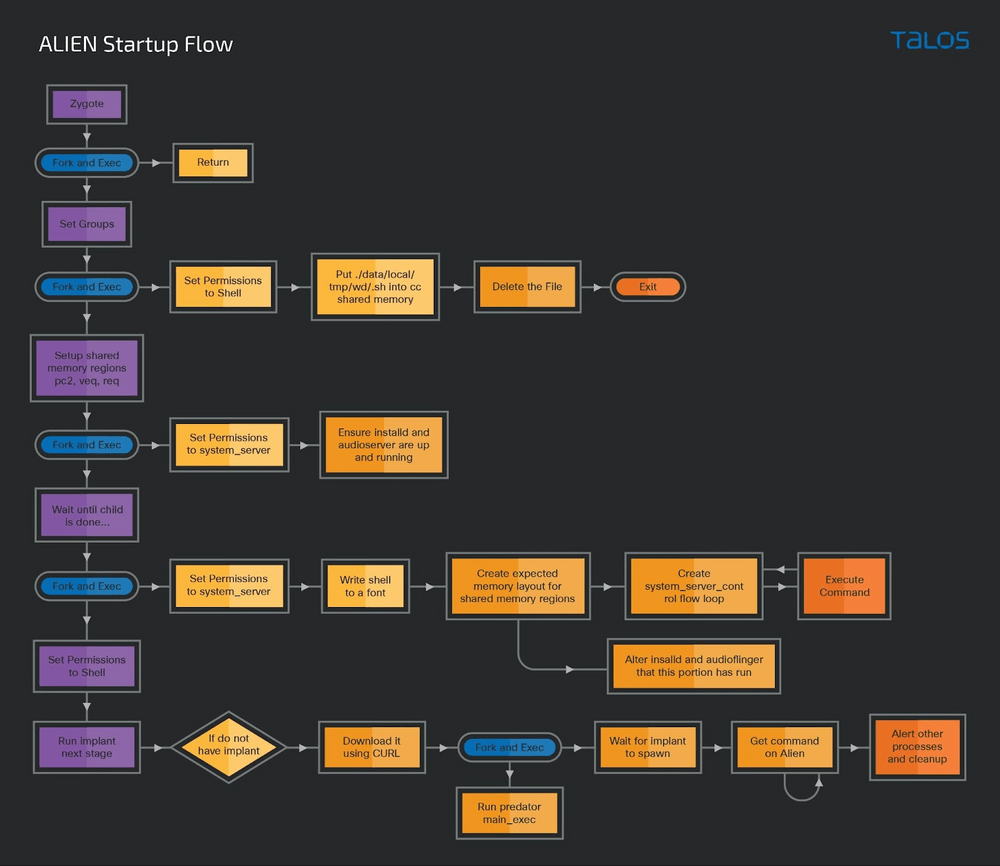Cisco Talos and the Citizen Lab researchers have published a technical analysis of the powerful Android spyware Predator.
Security researchers at Cisco Talos and the Citizen Lab have shared technical details about a commercial Android spyware named Predator that is sold by the surveillance firm Intellexa (formerly known as Cytrox).
The researchers focused their analysis on two components of the mobile spyware implant, respectively tracked as “ALIEN” and “PREDATOR.”
“PREDATOR is an interesting piece of mercenary spyware that has been around since at least 2019, designed to be flexible so that new Python-based modules can be delivered without the need for repeated exploitation, thus making it especially versatile and dangerous.” reads the post published by Cisco Talos. “New analysis from Talos uncovered the inner workings of PREDATOR and the mechanisms it uses to communicate with the other spyware component deployed along with it known as “ALIEN.” Both components work together to bypass traditional security features on the Android operating system. Our findings reveal the extent of the interweaving of capabilities between PREDATOR and ALIEN, providing proof that ALIEN is much more than just a loader for PREDATOR as previously thought to be.”
In May 2022, Google’s Threat Analysis Group (TAG) researchers discovered three campaigns, between August and October 2021, targeting Android users with five zero-day vulnerabilities.
The attacks aimed at installing the surveillance spyware Predator, developed by the North Macedonian firm Cytrox.
According to Google, the exploits were included in Cytrox’s commercial surveillance spyware that is sold to different nation-state actors, including Egypt, Armenia, Greece, Madagascar, Côte d’Ivoire, Serbia, Spain, and Indonesia.
In December 2021 a report published by CitizenLab researchers detailed the use of the Predator Spyware against exiled politician Ayman Nour and the host of a popular news program.
The surveillance software supports common spyware capabilities, such as recording phone calls, spying on messaging apps, and data harvesting on infected Android devices.
Currently, the Predator spyware is developed and sold by Israeli company Intellexa, it can target both iOS and Android devices. The surveillance suite offered by Intellexa has multiple components that Talos grouped into three major categories, exploitation, privilege escalation, and malware deployment.
The first two groups are related to components involved in the exploitation of remote vulnerabilities in the devices to achieve remote code execution (RCE) execution followed by the privilege escalation.
“When used together, these components provide a variety of information stealing, surveillance and remote-access capabilities. The functionalities described here are just a subset of the comprehensive capabilities of the spyware. At this time, Talos does not have access to all components of the spyware; therefore, this capability list should not be considered exhaustive.” continues the report. “We believe that capabilities like geolocation tracking, camera access or the ability to make it appear as if the phone is powering off may have been implemented in the tcore module.”
The researchers reported that the implant runs a variety of processes to bypass security measured supported by Android OS. The malware takes the “__progname” of the process that is currently running and then uses it to decide what set of functions to call. The Alien component is loaded into the Android process named ‘zygote64,’ then it fetches and launches additional components, including the Predator one.
The zygote64 and system_server call chains are the most active in performing tasks, while the installd call chain is responsible for establishing file structures for other components of the spyware. Each of these call chains creates a process structure that intercepts specific ioctl commands, allowing the spyware to exploit the SELinux context and grant different functionalities to other processes.
Alien also upgrades the existing Predator payload to a newer version if available.
Talos experts reported that ALIEN is not just a loader, but it is also able to execute multiple commands issued by the PREDATOR.
ALIEN hooks the ioctl() function in libbinder.so, which is used in the Android framework for inter-process communication.
“This ioctl hook manages a variety of different binder commands, inside of the BINDER_WRITE_READ IOCTL command. This hook filters all the BINDER_WRITE_READ functions to ALIEN’s own handler commands.” continues the analysis. “The commands that are redirected include BC_TRANSACTION, BR_TRANSACTION, BR_REPLY, BC_REPLY. This allows the control of information into and out of the target process. Within each of the selected processes mentioned above, there are different actions a malicious module could then take on the system. This creates an effective way to communicate within the implant while also allowing the implant to hide within other legitimate system processes. The implant communicates discreetly with itself, without network-based indicators and avoiding SELinux restrictions.”
PREDATOR is the core component of the implant, it is a pyfrozen ELF file that contains serialized Python modules and native code. ALIEN calls the main_exec() function to launch PREDATOR.

The Alien component checks the device manufacturer name, if it running on Samsung, Huawei, Oppo, or Xiaomi devices, it iteratively accesses the contents of directories where user data from email, messaging, social media, and browser apps are stored. It also access
It also enumerates the victim’s list of contacts and the user’s media folders, to access audio, images, and video on the compromised device.
The experts pointed out that they were not able to analyze all the components composing the surveillance suite, in particular, they speculate the execution of two additional components.
“We assess with high confidence that the spyware has two additional components — tcore (main component) and kmem (privilege escalation mechanic) — but we were unable to obtain and analyze these modules.” concludes the report.
Follow me on Twitter: @securityaffairs and Facebook and Mastodon
(SecurityAffairs – hacking, spyware)
The post Researchers analyzed the PREDATOR spyware and its loader Alien appeared first on Security Affairs.

